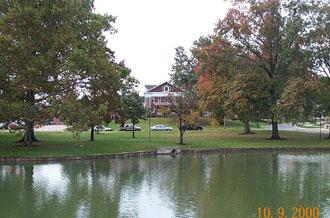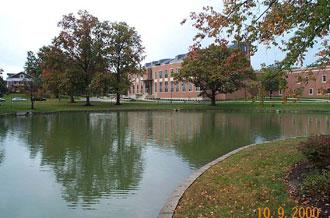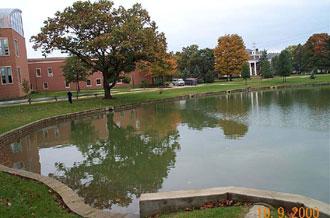College Student Drowns In Campus Lake
Responding Police, Fire and Rescue Agency personnel fail to initiate rescue efforts.




During the early morning of May 3, 1998, at approximately 12:15 AM,, 2 college students entered the lake located on their college campus while other friends looked on. The weather was mild, but the water temperature was cold and estimated at approximately 50 degrees Fahrenheit. Both students entered the water from the bank in front of their fraternity house with the intent of swimming across the lake to the area of the foot bridge. According to one student, “…they decided it was too far of a swim so they turned around and started to swim back.” When he got to shallow water, he looked back and could not see the other swimmer. While several of the friends entered the water in an attempt to search for him, another student ran down to the lake from the Fraternity House and then ran back to call the police. When College Campus Security arrived on the scene, they ordered everyone out of the water, but the students continued their efforts to locate the victim. When town Police personnel arrived on the scene, they ordered the students to discontinue their search and rescue efforts and ordered them out of the water.
No efforts were made by either the College Security Department or the town Police Department to search for and rescue the victim. The town Police Department called for the town Fire Department for lighting. The Fire Department was dispatched at approximately 12:30 AM and responded with 14 personnel from Engine 10, Engine 11, Rescue 16, and Chief 1. The County Coroner was also requested. All Fire Department units arrived on the scene between 12:33 AM and 12:39 AM. The Fire Department did not attempt any search and rescue efforts and requested the Township Dive Team who were dispatched at 12:54 AM and arrived on the scene between 1:28 AM and 1:38 AM with 9 personnel.
The Township Dive Team recovered the victim from approximately 11 feet of water. He was transported to the Community Hospital by Metro Ambulance and was pronounced dead at the hospital.
Opinions of Expert
During the early morning hours of May 3, 1998, the College had a duty to their students, faculty, and guests to provide safety and security services, and to provide a campus free of unreasonable physical hazards and dangers. The College failed to meet that duty which resulted in the drowning death of a 19-year-old student on that date.
The College failed to conduct a threat analysis of their campus as part of their comprehensive Risk Management Program. As a result, they failed to assess and realize the risks, hazards and dangers associated with the two lakes located on campus. They failed to develop appropriate drowning prevention strategies, and they failed to warn students of the risks, hazards and dangers associated with use of the lakes. The College publishes a Student Handbook which includes Students Rights and Responsibilities, but does not address any warnings or prohibitions pertaining to the use of the lakes.
The College Lakes are evident and pictured throughout college publications that include their web site, handbook, yearbook, and other literature. But, there are no warnings provided or signage evident to prohibit entry into the lakes or to warn of the potential drowning and injury hazards which exist. In fact, the web site and literature presents the lakes as an attraction and encourages students to congregate around the lakes and to “dangle their feet” in the lakes.
The College lakes were designed for storm water retention with catch/sediment collection basins that were dug in the bottom of both lakes. These lakes are not spring fed and are solely fed by storm water. The bottom of the lakes are uneven and present numerous hazards including debris, rocks, holes, etc. There is no filtration or disinfection of the lake water. As a result, these lakes present a physical hazard and dangerous situation to anyone in, on and around the lakes.
The administration of the College failed to evaluate the threat of the lakes and to collaborate between departments to discuss the threat and develop appropriate prevention strategies. The College has a swimming pool on campus which is staffed with Lifeguard personnel and other Aquatic and Recreation professionals. These people would have been appropriate resources to develop prevention strategies and emergency management systems should an incident occur in or around the lakes.
The College Security office and administration of the College failed to collaborate with town’s Fire and Rescue Services to develop emergency response plans involving incidents in, on and around the lakes. The town Fire Department currently conducts walk-through inspections of various buildings on the campus in order to pre-plan emergency incidents. However, this collaboration and pre-planning was not done with respect to the lakes which was evident by the response of the Fire and Rescue personnel and their inability to initiate search and rescue efforts for the victim during the early morning of May 3, 1998.
Search and rescue efforts should have been initiated immediately upon arrival of emergency service agencies during the morning of May 3, 1998. Once the College Security personnel, along with the town Police Department secured the scene, immediate search and rescue efforts should have been initiated. Upon arrival of the Fire and Rescue Department, rescue personnel should have been in the water searching for the victim in a coordinated search pattern. Equipment on the fire engines and other fire apparatus would have been available to probe the bottom of the lake. This equipment included Pike Poles and ladders. Fire and Rescue personnel should have formed human chains to sweep bottom of the lake to search for the victim.
Had immediate search and rescue efforts been initiated by the emergency service personnel responding to this incident, the victim would have been recovered from the lake within minutes of the search. Due to the temperature of the water, a successful resuscitation result could have been accomplished if he was rescued in a timely manner from the water and aggressive basic life support and advanced life support measures were implemented enroute to and at the hospital. Instead, the emergency services that did respond, including the College Security Department, the town’s Police Department, and the town’s Fire Department, considered this incident as a recovery incident, rather than as a rescue incident. This is evident by the fact that the Coroner was requested upon arrival of the Police Department, and that no search and rescue efforts were performed by any emergency service agency until the arrival of the Township Dive Team over an hour after the incident occurred.
Therefore, it is my opinion that the College had a duty to this victim during the early morning hours of May 3, 1998. The College breached that duty which was a cause of the drowning death of this 19-year-old victim.
The failure to conduct an appropriate threat analysis of their campus; the failure to implement an appropriate Risk Management Program; the failure to develop appropriate prevention strategies; the failure to warn of the dangers and conditions of the lake; and the failure to develop and implement appropriate emergency response pre-planning and preparedness were direct causes of this person’s death and prolonged submersion.


